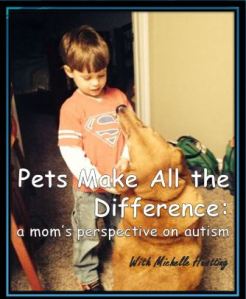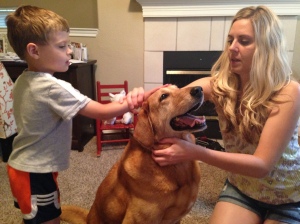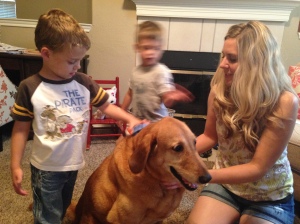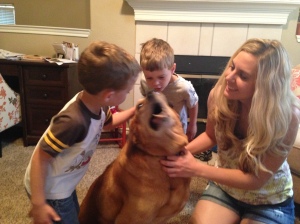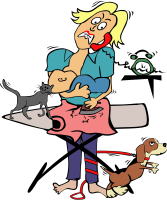Okay, so for all you men that read my blog title, you may or may not have rolled your eyes, but hear me out. Today discussing feelings matters for your dog and I promise this won’t be a painful conversation. 😉 For us ladies, I know we are all about this topic.
The way that you respond to your dog’s behavior creates an emotional response for him. Let’s think about this for a minute. Let’s say that you are in the beginning stages of falling in love with someone. Your emotions are strong. You have this yearning to be with that person. You can’t wait to be with that person. It’s intense. There are butterflies, roses, and rainbows when you think of this person or hear this person’s name. You cannot wait to spend time together.
On the other end of the spectrum, maybe you’ve been fighting with someone for months. Everything now that he/she says and does annoys you. You even hate the way he or she holds the fork, chews food, or says certain words. You cannot even stand the idea of being in the same room with that person.
Emotional associations matter for us, and emotions matter for dogs as well. Your response, positive or negative, to your dog coming to you will make all the difference in the world.
Has your dog ever run away from you? What did you do? If your dog does run away from youc never, ever, ever (Did I say that enough times??) punish, yell, spank, or act annoyed with your dog. Please. Never. The way that you respond to your dog, especially with the cue come, will determine his response. It’s important to be appear unfazed even if you are upset. You want him to want to want to come to you, not the opposite.
But It’s a Negative
For a moment let’s think about things from the dog’s perspective. You have a coworker that starts off saying something positive, but you know she will end with a negative. “You did a good job, BUT…” “I like your shirt, but gosh, it’s probably too tight for the office.” You will begin to dread any sort of positive thing that comes out of her mouth because you know that there is a negative “but” that follows.
Similarly, when working on the come cue, you must always think about things from the dog’s perspective. In other words, what is negative for him? And whatever is negative for him, do not pair it with the cue come. What does this mean? A very good example would be illustrated in my group class for basic manners where we work on recalls. The dog comes running in hard to the owner and performs what is actually quite a beautiful come. When the dog gets close to the owner to get his yummy treat, the owner gives it to him and then starts petting him like crazy. Typically what I see at this point is the dog backing up. He is backing up because at that moment he did not want to petted. He wanted a treat. Now, because of this first association, on the second recall that we do, the dog doesn’t run as fast to the owner.
What are some things that are your dog may perceive as a negative?
- When he is at the dog park, and owner cues come, leashes the dog and then leaves the park.
- Before you leave for work, you cue come, and put the dog in the kennel for 7 hours.
- Owner cues come. The dog runs up to the owner, and the owner pets the dog. The dog backs up because he doesn’t enjoy someone petting his face.
A negative doesn’t necessarily have to come in the form of you yelling at your dog. A negative is anything that he finds unpleasant or he just doesn’t like. You want the cue come to mean rainbows and butterflies, a day without rain or flies, because feelings really do matter.
Hear the cue “come” –> Feel happy –> Run to owner
Eww, Yuck!
So one of the most rewarding things that I have going on in my life is being a mother. I have beautiful identical twin boys that rock my world. They will soon be 5 years old as I write this. Sometimes the things they say crack me up.
A few mornings ago I was making my green drink (yes, a health nut too). I mix carrot juice with my green drink. Anthony saw the carrot juice and wanted some. I poured a little bit into his cup and handed it to him. After he tasted it, I asked, “You like it, Anthony?” “No!” he said as he placed the cup back on the counter. “YUCK!” As a result of this negative experience, he won’t even touch an orange-colored juice again. Why? Because the first orange-colored drink he tried was gross to him, and that was that.
There are times that the cue come has become like carrot juice to Anthony. He sees it, and he is not interested. Your dog hears come and he runs. The scientific term for this is a “poisoned cue,” a result that occurs from calling come and doing something your dog doesn’t like (putting him into a kennel, leaving him for the day, petting him in a way he doesn’t appreciate, or putting him into the tub for a bath, etc.), but it can also be caused by punishing your dog. Let’s just say your dog runs away, and you finally catch him and then spank him. If I were your dog, I wouldn’t ever want to come to you again either!
When I had my training facility in Iowa, I had a couple working with me on come with their dog. They said their dog knew come, so I had them say their recall cue and then watched their dog literally run as fast as he could to the opposite end of the facility. They obviously had poisoned the cue somewhere along the line.
If your cue has been poisoned, you will need to start from scratch. In other words, you will need to create a new come cue as if you have never taught come before. It is back to the basics for you and your dog.
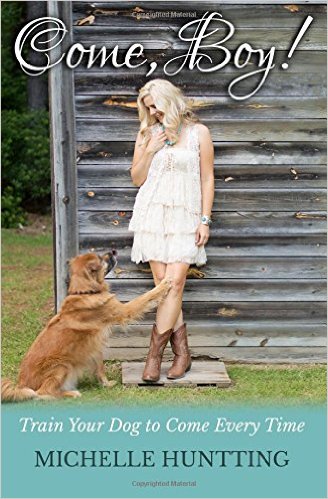
Training tip from my book “Come, Boy!”
Michelle Huntting
Building the bridge of communication between dog and canine guardian

